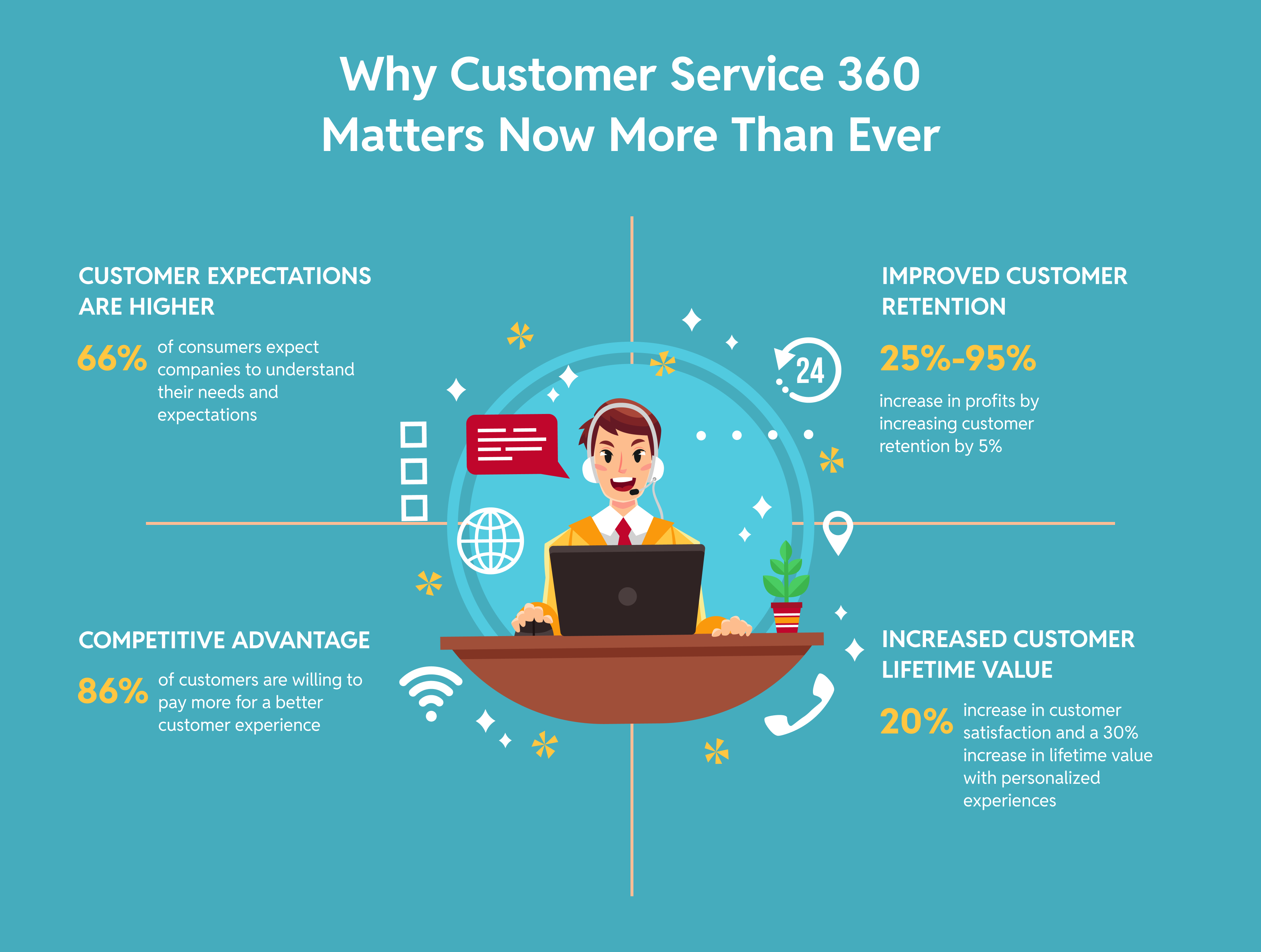Customer service has evolved from a basic support function to a strategic cornerstone of business success. According to a 2023 report by PwC, 73% of customers point to customer experience as an important factor in their purchasing decisions, surpassing even price and product quality1.
In today’s competitive market, companies are no longer just providing a service—they are cultivating relationships. A 360-degree approach to customer service goes beyond merely addressing customer inquiries; it creates a comprehensive, personalized experience that fosters trust, loyalty, and long-term connections. In this article, we will delve into the power of the 360-degree model, exploring how it enhances customer interactions and transforms one-time transactions into lasting partnerships.
What is a 360-Degree Approach to Customer Service?
A 360-degree approach to customer service involves understanding and managing every aspect of the customer experience. This means having a complete view of customer interactions across multiple touchpoints—whether it’s through phone calls, emails, social media, in-store visits, or website interactions. By integrating all customer data into one cohesive platform, businesses can tailor their approach to the individual customer, offering a more personalized, effective, and consistent service experience. According to a 2022 Salesforce study, 70% of consumers say connected processes are very important to winning their business.2
Instead of simply reacting to customer inquiries and issues, the 360-degree model allows businesses to anticipate customer needs, resolve problems proactively, and engage clients in meaningful, personalized ways that foster loyalty and trust.

Why Customer Service 360 Matters Now More Than Ever
As competition intensifies and consumer choices increase, businesses must work harder than ever to stand out. A 360-degree approach to customer service helps companies create a stronger bond with their clients, providing a competitive edge that keeps customers coming back. Here’s why it matters:
Customer Expectations Are Higher
Improved Customer Retention
Competitive Advantage
Increased Customer Lifetime Value

Best Practices for Implementing Customer Service 360
Centralize Customer Data
The foundation of a 360-degree customer service model is access to comprehensive, up-to-date customer data. By centralizing customer data from multiple sources into one unified system, businesses can gain a holistic view of the customer’s history, preferences, and behavior. This allows support teams to respond faster and more accurately, anticipating customer needs.
Utilize Omnichannel Communication
Customers expect to reach businesses through various channels—whether it’s phone, email, chat, social media, or in-person. A 360-degree approach incorporates all of these touchpoints, allowing businesses to engage with customers on their preferred platforms. Having a consistent brand voice and message across all channels ensures that customers receive the same level of service, regardless of the communication method.
Personalize Interactions
Customers want to feel like more than just a number. By using data and insights gathered from previous interactions, businesses can tailor their responses and solutions to the specific needs of each customer. For example, greeting returning customers by name, acknowledging previous issues or inquiries, and recommending products or services based on their preferences all contribute to a more personalized experience.
Proactively Solve Problems
Instead of waiting for customers to reach out with issues, proactive customer service anticipates potential problems and addresses them before they become an issue. For example, if there’s a shipping delay, proactively informing customers and offering a solution can prevent frustration and demonstrate that you’re committed to their satisfaction.

Train and Empower Your Team
A 360-degree approach to customer service requires a well-trained, responsive team that can handle diverse customer needs. Equip your customer service representatives with the tools, training, and authority to resolve issues quickly and effectively. Empowering employees to take ownership of customer issues and ensuring they have the necessary resources will result in higher satisfaction and more efficient service.
Leverage Technology and Automation
Collect and Act on Feedback
Continuous improvement is a key component of a successful 360-degree service model. Regularly gathering customer feedback—through surveys, direct conversations, or monitoring social media—helps businesses identify areas of improvement. Taking actionable steps based on feedback ensures that customers feel valued and that their concerns are addressed.
How Customer Service 360 Transforms Client Interactions into Lasting Relationships
A 360-degree approach is not just about solving problems; it’s about building relationships. Here’s how this strategy fosters lasting customer connections:

Building Trust and Loyalty
By understanding customer preferences, addressing their concerns before they arise, and providing tailored recommendations, businesses build trust and loyalty. When customers feel like a brand genuinely cares about their needs, they are more likely to remain loyal and continue their relationship with the company.

Enhancing Satisfaction

Creating Advocacy
Loyal customers become brand advocates. When businesses go above and beyond in delivering exceptional customer service, they turn their clients into powerful marketing assets. Word-of-mouth referrals and positive reviews can be some of the most effective ways to grow your business.

Fostering Emotional Connections
The best customer service doesn’t just address practical needs—it connects with customers on an emotional level. A genuine, empathetic approach to problem-solving, along with personalized service, makes customers feel valued and respected. This emotional connection is key to long-term loyalty.
The Role of XMC360 in Enhancing Customer Service 360
At XMC360, we believe that great customer service is a cornerstone of sustainable business growth. Our customer service solutions are designed to help businesses implement a 360-degree approach, improving engagement, satisfaction, and loyalty. We offer customized solutions tailored to your company’s unique needs, integrating advanced technology, data analytics, and omnichannel communication tools to streamline customer service operations and enhance the customer experience.
By embracing a 360-degree approach to customer service, your business can transform client interactions into lasting relationships, driving growth and ensuring long-term success.

Conclusion
In today’s competitive business environment, exceptional customer service is more than just a necessity—it’s a strategic advantage. Adopting a 360-degree approach to customer service allows businesses to provide personalized, proactive, and seamless experiences that drive satisfaction, loyalty, and long-term success.
At XMC360, we help companies unlock the full potential of customer service by implementing strategies and technologies that enhance every aspect of the customer experience. Ready to transform your customer service approach? Contact XMC360 today to learn how we can help you build lasting relationships with your clients.
References:
- PwC, “Experience is Everything: Here’s How to Get It Right,” 2023.
- Salesforce, “State of the Connected Customer,” 2022.
- Zendesk, “Zendesk CX Trends Report,” 2023.
- Bain & Company, “The Loyalty Effect,” 2022.
- American Express, “Customer Service Barometer,” 2023.
- McKinsey & Company, “The Customer Experience Report,” 2023.
- Gartner, “Customer Service Trends to Watch in 2024,” 2024.
- Temkin Group, “Customer Experience and Loyalty,” 2023.


